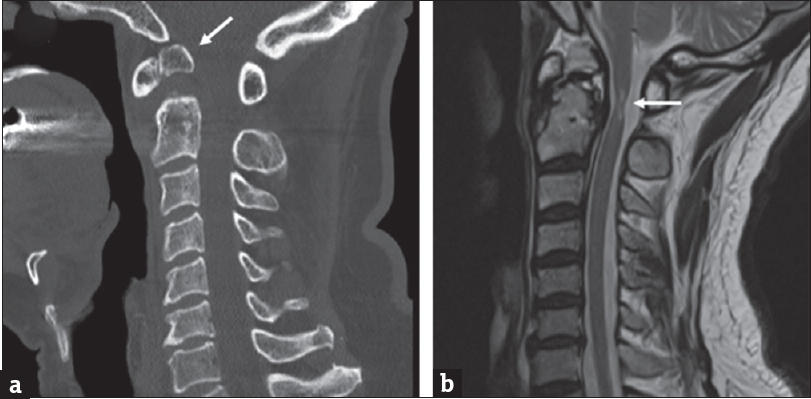Translate this page into:
Os Odontoideum
This is an open access journal, and articles are distributed under the terms of the Creative Commons Attribution-NonCommercial-ShareAlike 4.0 License, which allows others to remix, tweak, and build upon the work non-commercially, as long as appropriate credit is given and the new creations are licensed under the identical terms.
This article was originally published by Medknow Publications & Media Pvt Ltd and was migrated to Scientific Scholar after the change of Publisher.
A 73-year-old patient presented to the neurosurgery clinic with a 2-year history of progressive paresthesia and deterioration of the dexterity of his right hand.
Neurologic examination revealed an impairment of fine motor skills of both hands and spastic hypertonus of the lower extremities. Computed tomography of the cervical spine showed a smooth-margined, independent osseous segment separated from the hypoplastic odontoid peg consistent with os odontoideum [Figure 1a, arrow].

- (a) Sagittal computed tomography of the cervical spine shows a separate odontoid process (arrow) from the body of C2. (b) Sagittal T2-weighted cervical magnetic resonance imaging reveals narrowing and hyperintensity (arrow) of the spinal cord at C2 level
The etiology of os odontoideum remains controversial with traumatic or congenital hypothesis.[12] It is incidentally discovered or seen in symptomatic patients with cervical myelopathy because of C1–C2 instability and spinal cord compression.[12] In this patient, magnetic resonance imaging revealed narrowing and hyperintensity of the spinal cord at C2 level on the T2-weighted sequence [Figure 1b, arrow]. C1–C2 posterior screw-rod stabilization was performed. Within 2 months after surgery, paresthesia had resolved, and the patient was able to write again.
Declaration of patient consent
The authors certify that they have obtained all appropriate patient consent forms. In the form, the patient has given his consent for his images and other clinical information to be reported in the journal. The patient understands that name and initials will not be published and due efforts will be made to conceal identity, but anonymity cannot be guaranteed.
Financial support and sponsorship
Nil.
Conflicts of interest
There are no conflicts of interest.
REFERENCES
- Incidental os odontoideum: Current management strategies. Neurosurg Focus. 2011;31:E10.
- [Google Scholar]





